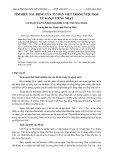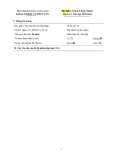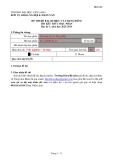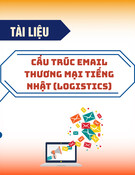
A tangent to a circle is a line that has exactly one point in common with the
circle. A radius with its endpoint at the point of tangency is perpendicular to the
tangent line. The converse is also true.
If each vertex of a polygon lies on a circle, then the polygon is inscribed
in the circle, or equivalently, the circle is circumscribed about the polygon.
Triangle RST below is inscribed in the circle with center O.
If each side of a polygon is tangent to a given circle, then the polygon is
circumscribed about the circle, or equivalently, the circle is inscribed in the
polygon. In the figure below, quadrilateral ABCD is circumscribed about the
circle with center O.
Two or more circles with the same center are called concentric circles.
44
For more material and information, please visit Tai Lieu Du Hoc at www.tailieuduhoc.org

3.6 Three-Dimensional Figures
Basic three-dimensional figures include rectangular solids, cubes, cylinders,
spheres, pyramids, and cones. In this section, we look at some properties of
rectangular solids and right circular cylinders.
(a) A rectangular solid has six rectangular surfaces called faces (see figure
below). Each line segment shown is called an edge (there are 12 edges),
and each point at which the edges meet is called a vertex (there are
8 vertices). The dimensions of a rectangular solid are length (),l
width (w), and height (h).
A rectangular solid with l==wh is called a cube. The volume V of
a rectangular solid is the product of the three dimensions,
V =l
wh
.
The surface area A of a rectangular solid is the sum of the areas of the
six faces, or
A =
+
+2( ).whwhll
For example, if a rectangular solid has length 8.5, width 5, and height 10,
then its volume is
V ==(8. )(
)(
),55
10
425
and its surface area is
A =++=25 5 5
10
510 355[( )(8. ) (8.
)(
)()()] .
45
For more material and information, please visit Tai Lieu Du Hoc at www.tailieuduhoc.org

(b) A right circular cylinder is shown in the figure below. Its bases are
circles with equal radii and centers P and Q, respectively, and its height
PQ is perpendicular to both bases.
The volume V of a right circular cylinder with a base radius r and
height h is the area of the base multiplied by the height, or
V =
p
r
h
2.
The surface area A of a right circular cylinder is the sum of the two
base areas and the area of the curved surface, or
Ar rh=+22
2
pp
.
For example, if a right circular cylinder has a base radius of 3 and a
height of 6.5, then its volume is
V==
pp
()(.) . ,365 585
2
and its surface area is
A=+ =()( )() ()( )()(.) .23 236557
2
pp p
46
For more material and information, please visit Tai Lieu Du Hoc at www.tailieuduhoc.org

GEOMETRY EXERCISES
(Answers on page 50)
1. Lines l and m below are parallel. Find the values of x and y.
2. In the figure below,
AC
BC
=
. Find the values of x and y.
3. In the figure below, what relationship must hold among angle measures x,
y, and z ?
4. What is the sum of the measures of the interior angles of a decagon (10-sided
polygon) ?
5. If the polygon in #4 is regular, what is the measure of each interior angle?
6. The lengths of two sides of an isosceles triangle are 15 and 22, respectively.
What are the possible values of the perimeter?
47
For more material and information, please visit Tai Lieu Du Hoc at www.tailieuduhoc.org

7. In rectangle ABDE below,
A
B
BC
==57,, and CD
=
3. Find the
(a) area of ABDE
(b) area of triangle BCF
(c) length of AD
(d) perimeter of ABDE
8. In parallelogram ABCD below, find the
(a) area of ABCD
(b) perimeter of ABCD
(c) length of diagonal AC
9. The circle with center O below has radius 4. Find the
(a) circumference
(b) length of arc ABC
(c) area of the shaded region
48
For more material and information, please visit Tai Lieu Du Hoc at www.tailieuduhoc.org


![Đề thi Ngữ pháp tiếng Nhật 3 (kì 1 2021-2022) có đáp án [kèm đề thi]](https://cdn.tailieu.vn/images/document/thumbnail/2025/20250409/gaupanda086/135x160/9981744185437.jpg)

![Đề thi Tiếng Nhật IT học kì 1 năm 2023-2024 có đáp án [Mới nhất]](https://cdn.tailieu.vn/images/document/thumbnail/2025/20250210/gaupanda073/135x160/8311739169576.jpg)



![Đề thi Tiếng Nhật 4 học kì 2 năm 2023-2024 (có đáp án) - [Kèm đề thi kết thúc học phần]](https://cdn.tailieu.vn/images/document/thumbnail/2025/20250206/gaupanda072/135x160/1461738814500.jpg)
![Đề thi Tiếng Nhật 1 học kì 2 năm 2023-2024 có đáp án [kèm đề thi]](https://cdn.tailieu.vn/images/document/thumbnail/2025/20250206/gaupanda072/135x160/7661738814508.jpg)

![Bài giảng Tiếng Trung Quốc du lịch khách sạn [Tập hợp]](https://cdn.tailieu.vn/images/document/thumbnail/2025/20251003/kimphuong1001/135x160/7291759464952.jpg)
![Đề thi Tiếng Trung 1 học kì 2 năm 2024-2025 có đáp án (Đề 2) - [Tuyển tập đề thi]](https://cdn.tailieu.vn/images/document/thumbnail/2025/20250920/kimphuong1001/135x160/76371758358928.jpg)

![Tài liệu Ngữ pháp HSK 2 [mới nhất]](https://cdn.tailieu.vn/images/document/thumbnail/2025/20250916/thanhhoa.lda@gmail.com/135x160/3241757994918.jpg)

![Đề thi Tiếng Trung 1 học kì 2 năm 2024-2025 có đáp án (Đề 1) - [Tuyển tập]](https://cdn.tailieu.vn/images/document/thumbnail/2025/20250823/kimphuong1001/135x160/95221755919445.jpg)









